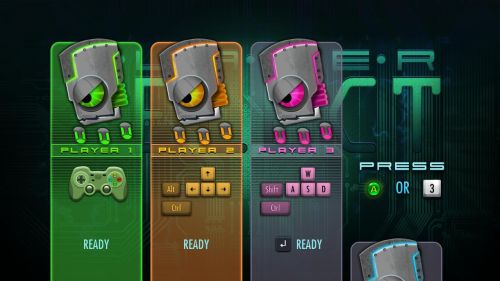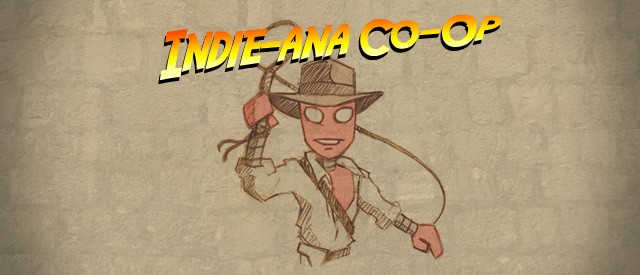It Takes a Village to Destroy a City
Puzzles aren’t cooperative. That's what I was told. You don't see teams of people solving Rubik’s cubes, and you don't see a cooperative mode in Braid (this was also before Portal 2). Cooperation was for killing terrorists, aliens, and zombies. Solving a complex puzzle is a solitary thing which requires concentration. Cooperation would just be annoying, adding a hindrance. I was also told puzzle games don't need stories. I decided mine was going to have both, because it's my damn game, and that's pretty much the beauty of being an indie dev.
4 Player: Just Add 3 Players?
Starting a cooperative puzzle game is easy. Just add more players! The first decisions that went into A Virus Named TOM were the easy ones. I didn't want splitscreen, or to deal with a shared camera, so the entire circuit would have to sit on a single screen. The circuit had 4 corners so each player could start in a nice safe place off the grid. I think somewhere in the recesses of my brain I thought that I could somehow pull a fast one. That I could just add 3 players and say "look, if you want, there's co-op play!"
Initially I tried to ignore the nagging reminders that it wasn't going to be that easy. Sure the single-player levels were fun for co-op, but some levels that would be great for co-op wouldn't work for single-player and vice versa. Trying to design levels that worked well for 1 - 4 players wasn't easy. It also bothered me that the entire co-op campaign could be defeated with a single player, while players 2 - 4 sat idly by. I told myself this was a "feature" because players of different skills could play together without the tension, but this felt hollow as time went on. I wanted players to need each other and affect one another, thereby creating a stronger connection.

1, 2, 3, 4 players... must be co-op!
The final straw was when I decided to go back to targeting a more core audience. The game started as a "core" game, targeting gamers that would enjoy a challenge in both puzzle and dexterity. As time went on and the casual marketplace opened up I got scarred and started making decisions that would be inclusive of as many player types as possible, therefore skewing more casual friendly. Eventually, this just didn't feel right. I knew how I originally intended the game to be played and didn't want to alter that experience, so I abandoned the casual slant and returned to my original core target demographic. This removed my need to support players of very disparate abilities and required at least 2 of the players to be fairly core players.
Why Make 54 Levels When You Can Make 108?
The decision to make co-op in the game a first class citizen was a difficult one, but one I'm very happy with. We're an extremely small team and this meant doubling the number of levels I would have to design, as well as adding co-op specific features to the game, such as barriers to force cooperation and roles awarded at the end of each level. In a way this made my life easier. Being able to assume at least 2 players in co-op levels, and only 1 in single-player levels made the level designs much more interesting and fun to create. This also, however, doubled my informal playtest sessions. To make matters worse, I did not have an office full of employees to test the co-op levels.
The only thing that made co-op possible was being in the IGN Indie Open House where people like David Rosen (Wolfire), Alex Austin (Cryptic Sea), and Justin Woodward (Interabang Ent) took time out of their days to run through levels so I could see what worked and what didn't. We also had lots of other bay area indies in, all of whom helped me time and time again by playing countless levels. Last but not least were our pre-order-ers, some of whom (the Surowiec's) were willing to play some of the final levels of the game early to give feedback. These levels had an even smaller number of play testers due to their difficulty and the requirement of having played the previous 40 or so levels to learn all the mechanics.
